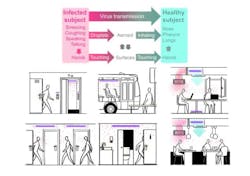Scientists recommend UV-C light to reduce indoor SARS-CoV-2 transmission
Studies show that COVID-19 virus transmission follows two main paths: first, the virus can transmit through air in droplets exhaled by infected individuals and inhaled by healthy individuals; and second, it can be deposited on surfaces from either exhalations or hand contact. Measures being adopted to help prevent transmission of this disease include facial masks and other physical barriers that, if properly used, have proven to be highly effective—but that depends on compliance of the population.
Numerous studies suggest that coronavirus transmission in indoor spaces has a much higher transmission rate than outdoors. Filters and chemicals have been presented as possible solutions to minimize this problem, but their installation and use can be costly and time-consuming. In another approach, chemicals such as ozone are very effective for virus disinfection, but are harmful to humans if misused.
In this context, Javier García de Abajo of the ICFO-Institut de Ciencies Fotoniques (Barcelona, Spain), Andreas Meyerhans (Universitat Pompeu Fabra) and Joan Rosell-Llompart (University Rovira i Virgili), together with Rufino Javier Hernández (University of the Basque Country, also in Barcelona), Ido Kaminer (Technion; Haifa, Israel), and Tilman Sanchez-Elsner (University of Southampton, UK), who form a team that is expert in the fields of virology, immunology, aerosols, architecture, and physics, have surveyed possible methods to prevent SARS-CoV-2 propagation in indoor spaces.1 Upon completion of the survey, they have chosen one measure that they believe to be particularly efficient, easily deployable, and economically affordable: virus inactivation by ultraviolet light.
The study gives information on currently available UV-C sources, such as fluorescent lamps, microcavity plasmas (which can deliver 172 nm light at an effeciency of greater than 20%), and LEDs, emphasizing that, by irradiating this type of light inside the ventilation systems of buildings and in shared indoor spaces while not in use, it is possible to quickly and efficiently deactivate airborne and surface-deposited SARS-CoV-2 viruses.
Sterilizing air ducts
For example, they note that UV-C (200 to 280 nm) radiation is reflected highly by aluminum even at high incidence angles (in the visible region, aluminum's reflectivity takes a dive at high angles); the importance of this becomes clear as the researchers describe the high effectiveness when UV-C light is sent down aluminum air ducts to sterilize them. The researchers especially recommend the use of UV-C light in the 207 to 222 nm wavelength range, as previous studies have shown that these wavelengths are less damaging to human skin.
They also explore costs and investments in deploying such technology and argue that a global capital investment of a few billion dollars in UV-C sources could protect of the order of one billion indoor workers worldwide.
Source: https://www.eurekalert.org/pub_releases/2020-06/iiop-sst062220.php
REFERENCE:
1. F. Javier García de Abajo et al., ACS Nano (2020); https://dx.doi.org/10.1021/acsnano.0c04596.

John Wallace | Senior Technical Editor (1998-2022)
John Wallace was with Laser Focus World for nearly 25 years, retiring in late June 2022. He obtained a bachelor's degree in mechanical engineering and physics at Rutgers University and a master's in optical engineering at the University of Rochester. Before becoming an editor, John worked as an engineer at RCA, Exxon, Eastman Kodak, and GCA Corporation.
